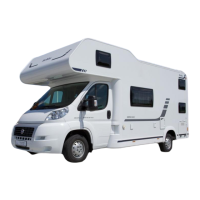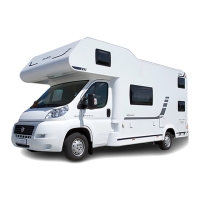02-5
Drawbar load
You will only achieve optimum driving stability
and decisively increase your safety on the road if
the drawbar load has been properly adjusted for
your combination of base vehicle and the cam-
per being pulled. The drawbar load indicates the
power the camper's drawbar exerts on the car's
clutch.
Rules for the drawbar load:
• Set the drawbar load correctly! You can, for
example, use normal bathroom scales: use a
strip of wood (approx. 400 mm long) to po-
sition them vertically under the coupling jaw.
It may also be possible to roughly estimate
the drawbar load by means of the drawbar
load scales
m
integrated in the front landing
wheel, whereby the drawbar of the camper
must be in a horizontal position.
• Always check the drawbar load before you
start to drive!
• The specied drawbar load (see handbook
or type plate) and the permissible overall
mass of the base vehicle and the camper may
not be exceeded!
How to adjust the correct drawbar load:
1. Determine the maximum drawbar load of your
base vehicle by checking its documentation,
the type plate or the drawbar plate.
2. Your HOBBY camper has a maximum per-
missible drawbar load of 100 kg.
3. Adjust the drawbar load on the camper to the
lower of the two values by loading it careful-
ly. At the same time, try to make full use of
this value.
4. The lower of the two specied values for the
drawbar load, i.e. that of the base vehicle or
the camper, may not be exceeded.
Stowage areas in the camper
- Light objects
j
such as towels and light-
weight laundry.
- Medium-weight objects
k
such as clothing,
laundry and food.
- Heavy objects
l
such as the outer tent, boat
motor or crates of drinks.
3
2
1
If your camper is equipped with a rear bicycle
rack, the reduction in the drawbar load created
by the bicycles must be compensated by the
rest of the load.
4

